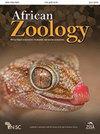Adding Another Piece to the Southern African Cercopithecus Monkey Phylogeography Puzzle
IF 0.5
4区 生物学
Q4 ZOOLOGY
引用次数: 2
Abstract
The taxonomy and number of Cercopithecus monkey radiation events in southern Africa are still debated. To date, genetic studies have largely been limited to single specimens per taxon and a scattered geographical distribution. A recent study focusing on South African Cercopithecus monkeys showed that populations can be divided into three distinct genetic entities. Our current study aims to add new mtDNA and microsatellite data from a coastal population (Vamizi Island) in Mozambique to compare to existing data from South Africa. Our additional data allowed analysis of the number and timing of radiation events of Cercopithecus monkeys in southern Africa. Here we propose the occurrence of a single, north-south radiation event during the mid-Pleistocene along the Afromontane forest belt and that after the Last Glacial Maximum, samango populations reradiated into (re)established coastal forests on a more local scale. Our population genetic data support this pattern for both Mozambican, as well as South African samango monkey populations. By including mtDNA sequence data from Cercopithecus across Africa, we also discuss the hypothesis that the ‘Kingdon Line’ may explain the divergence of two major species in Africa within the C. mitis/nictitans group: C. albogularis and C. mitis.为南部非洲Cercopithecus Monkey系统地理学难题再添一笔
南部非洲猴辐射事件的分类和数量仍存在争议。迄今为止,遗传学研究主要局限于每个分类单元的单个标本和分散的地理分布。最近一项针对南非南方古猿的研究表明,种群可以分为三个不同的遗传实体。我们目前的研究旨在添加莫桑比克沿海人口(瓦米齐岛)的新mtDNA和微卫星数据,与南非的现有数据进行比较。我们的额外数据使我们能够分析南部非洲Cercopithecus猴子辐射事件的数量和时间。在这里,我们提出了在更新世中期沿阿夫罗蒙坦林带发生的单一南北辐射事件,以及在最后一次冰川盛期之后,萨曼戈种群在更局部的范围内重新辐射到(重建)建立的沿海森林中。我们的种群遗传数据支持莫桑比克和南非萨曼戈猴种群的这种模式。通过纳入来自非洲Cercopithecus的mtDNA序列数据,我们还讨论了“Kingdon线”可能解释非洲两个主要物种在C.mitis/nictitans群中的差异的假设:C.albogularis和C.mitis。
本文章由计算机程序翻译,如有差异,请以英文原文为准。
求助全文
约1分钟内获得全文
求助全文
来源期刊

African Zoology
生物-动物学
CiteScore
2.60
自引率
9.10%
发文量
18
审稿时长
>12 weeks
期刊介绍:
African Zoology , a peer-reviewed research journal, publishes original scientific contributions and critical reviews that focus principally on African fauna in terrestrial, freshwater, and marine ecosystems. Research from other regions that advances practical and theoretical aspects of zoology will be considered. Rigorous question-driven research in all aspects of zoology will take precedence over descriptive research. The Journal publishes full-length papers, critical reviews, short communications, letters to the editors as well as book reviews. Contributions based on purely observational, descriptive or anecdotal data will not be considered.
The Journal is produced by NISC in association with the Zoological Society of South Africa (ZSSA). Acceptance of papers is the responsibility of the Editors-in-Chief in consultation with the Editors and members of the Editorial Advisory Board. All views expressed are those of the author and not necessarily those of the Editors or the Department.
 求助内容:
求助内容: 应助结果提醒方式:
应助结果提醒方式:


